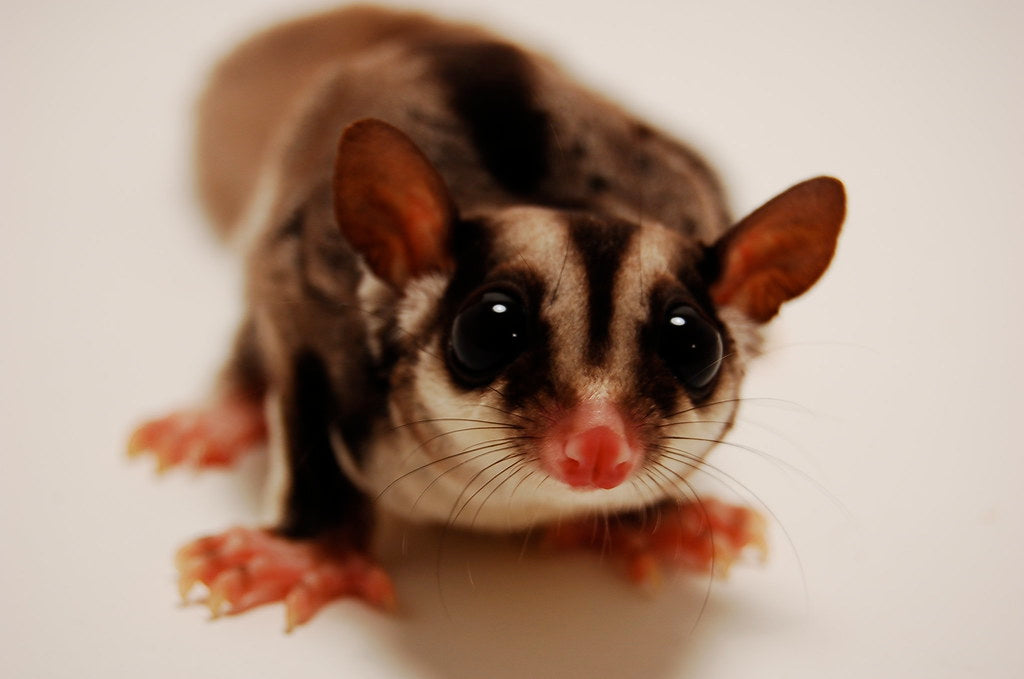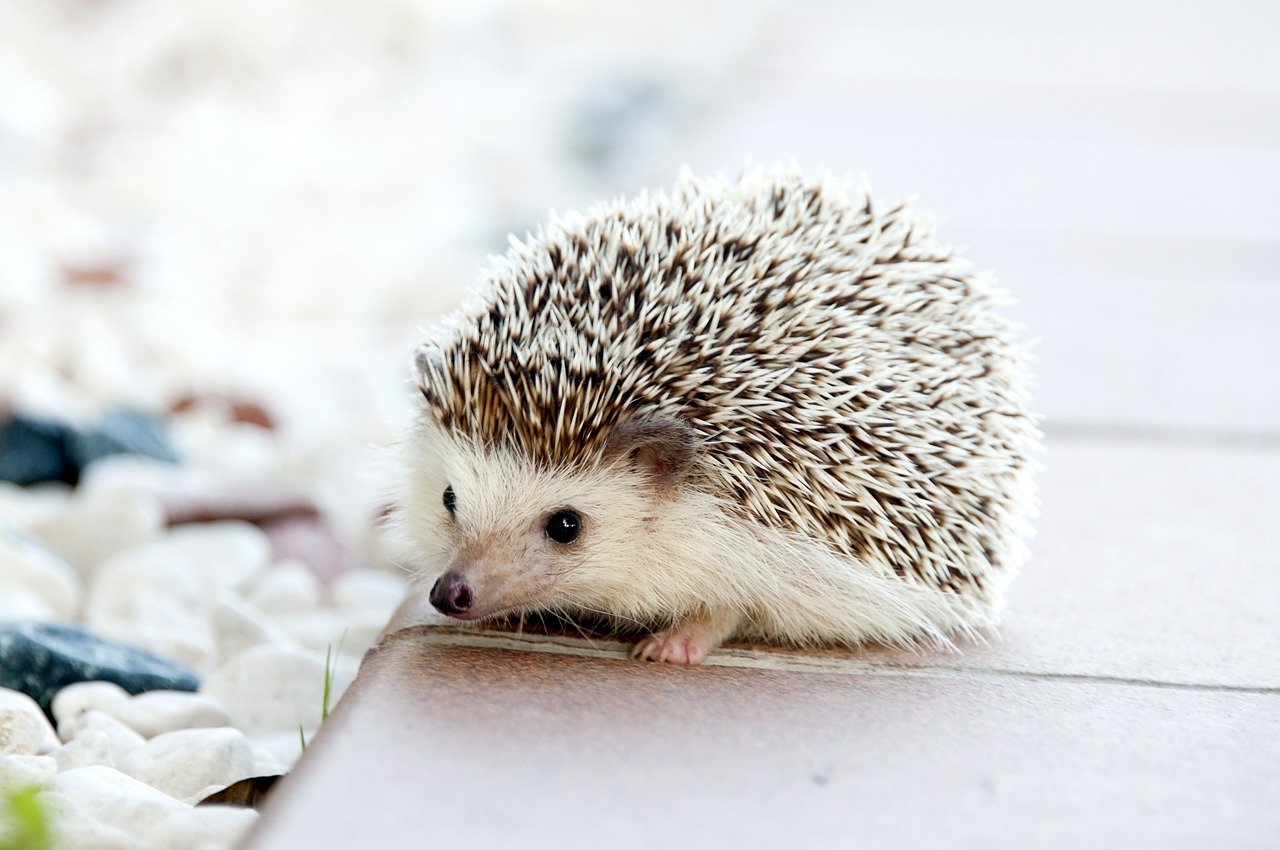Sugar gliders (Petaurus breviceps) are a small, arboreal, nocturnal exotic mammal that can be found primarily in Australia and New Guinea. They occupy various types of forest habitats, as long as the climate is comfortable, trees available, and food plentiful. This species is also known as a “sugar bear.”
Sugar gliders generally have a 5-6” long body with a tail roughly the same length. They have a pointed head, large dark eyes, medium-sized ears, short dense fur, strong toes and claws, a semi-prehensile tail, and flaps of skin that allow them to glide. Coloring is gray with a pale belly and pink nose and feet. Pattern includes a dark dorsal stripe from the nose to the tail, and additional stripes through each eye.
Sugar gliders are demanding pets that require a significant amount of commitment from the keeper, and their nocturnal nature can make them frustrating to keep. However, with good care, sugar gliders may live up to 17 years.
Note: Sugar gliders are illegal to keep in some states, so make sure to check your local laws before getting this pet!
How much space do sugar gliders need?
Sugar gliders are quite active at night, and capable of gliding up to 45 meters, which means that they need plenty of space to move around. While the enclosure doesn’t need to be the size of a large room, the minimum for housing a pair is 2’L x 2’W x 3’H, with larger being preferred. If the enclosure is made of wire mesh, holes should be no larger than 1” x 0.5” in order to prevent escape. Cover the cage on 2-3 sides to help reduce stress.
Sugar gliders are extremely social animals, so cohabitation (keeping multiple sugar gliders in one enclosure) is required for this species’ wellbeing. It’s best to house them in groups of at least two or three. Avoid housing multiple males together with females, as they may start to fight during breeding season. It’s ideal to get your group from the same litter, but if you need to introduce strangers to the same cage, they will need to be introduced gradually.
The more sugar gliders you want to keep, the larger the enclosure will need to be in order for everyone to stay happy and get along.
Do sugar gliders need special lighting?
No, the light you have on in the room should be plenty. All lights should be turned off at night.
What temperatures do sugar gliders need?
It’s best to keep your sugar gliders between 75-88°F, as lower temperatures can negatively affect their health. If the room you’re keeping them in isn't warm enough, a radiant heat panel installed on top of the cage and regulated by a thermostat will solve the problem. Make sure your sugar gliders can’t come into direct contact with the heating element.
What humidity levels do sugar gliders need?
The humidity levels in sugar glider habitat are generally between 70-90%, which is likely to be significantly higher than the level of humidity in your home. To remedy this, you can add a humidifier to the room, or you can install a fogger in the cage, connected to a humidistat.
What substrate is good for sugar gliders?
Although sugar gliders are arboreal and don’t spend time on the floor of their cage, using substrate/bedding is a good way to maintain good hygiene. Here are some options to consider:
- Carefresh
- Paper towels
- Alfalfa pellets
- Fleece fabric
- Aspen shavings
Substrate should be 2” deep and completely replaced weekly. Sugar gliders cannot be trained to use a litter box.
What décor can you use in a sugar glider cage?
It’s terribly stressful for a sugar glider to be stuck in an enclosure with nothing in it except bedding and food/water bowls. It doesn’t matter how big the enclosure is if you don’t put things in it for your pet to use and interact with!
Most importantly, you will need to provide at least one hide box or nest for your pets to use, preferably multiple in order to give them the freedom of choice. Aside from this, you will need to provide items for climbing, perching, and entertainment, such as:
- branches
- vines
- ropes
- hammocks
- ledges
- swings
- bird toys
- chew toys
What do sugar gliders eat?
Sugar gliders are omnivores, which means that they need both plant and animal matter in their diet in order to get the nutrition that they need. This diet should be roughly 25% fruits and vegetables, and 75% commercial diet, OR 25% fruits and vegetables, 25% protein, and 50% Leadbeater’s mix.
Offer food daily, but not too much, as obesity is common in this species. If you notice that your sugar glider is getting fat, reduce the amount it’s being fed and encourage more exercise through handling/supervised free-roaming.
Food and water bowls should be placed high up in the cage, rather than on the ground, for the sugar gliders to easily access. For balanced nutrition, offer your sugar glider as much variety in diet as possible:
Vegetables for sugar gliders: carrots, sweet potato, lettuce, collard greens, kale, cucumber, fresh eucalyptus leaves
Fruits for sugar gliders: apples, bananas, berries, melon, figs, grapes, mangoes, grapefruit, oranges, peaches, pineapple, kiwi, papaya
Protein options for sugar gliders: black soldier fly larvae, crickets, mealworms, earthworms, hard-boiled eggs
Commercial diets for sugar gliders: Mazuri Insectivore Diet, Exotic Nutrition’s Premium Diet, Nutrimax sugar glider diet, High Protein Wombaroo diet
Water
Water should always be available to your sugar gliders, or else they will get dehydrated. The best way to do this is with a standard rodent water bottle mounted on the side of the cage near a ledge or somewhere else for the sugar glider to sit while drinking.
Due to concerns about the fluctuating trace chemicals in tap water, it’s best to only use bottled or spring water for your sugar gliders.
Supplements
A good multivitamin and calcium supplement should be lightly sprinkled over fruits and vegetables every other day, such as VitaMax and Glide-A-Mins. A little bit of bee pollen powder is also a good idea.
You will also need something called “Leadbeater’s mix,” offered daily. This is a very important dietary supplement that acts as something of a replacement for sugar glider’s wild diet of tree gum. You can find a reliable recipe for this mixture at LafeberVet.
Do sugar gliders like to be handled?
It’s best to get your sugar gliders at 8-12 weeks old, as this makes bonding and handling easier than when they’re older. After bringing your sugar gliders home, don’t handle them for the first two days so they can settle in. Then, place one of your old, dirty, sweaty shirts in the enclosure so they can get used to your scent. After a few days of this, introduce yourself and start handling. Wait until the sugar gliders are awake, and don’t grab or chase them. Gently scoop them, and repeat this ritual for at least two hours every night.
Bonding usually takes about 4-6 weeks to accomplish.
*This care sheet contains only very basic information. Although it’s a good introduction, please do further research with high-quality sources to obtain additional information on caring for this species.
"Sugar Glider" by GarrettTT is licensed under CC BY-SA 2.0



Leave a comment
This site is protected by hCaptcha and the hCaptcha Privacy Policy and Terms of Service apply.